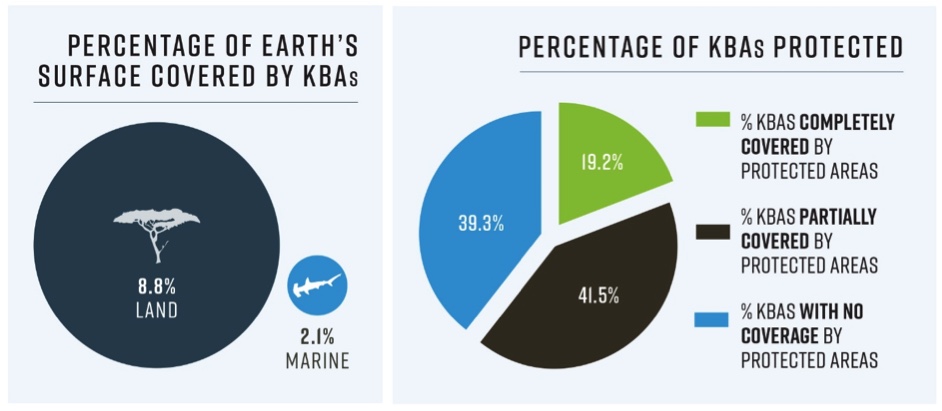Why KBAs should be in the CBD Targets and Indicators for the Post 2020 Global Biodiversity Framework

Key Biodiversity Areas (KBAs) are sites of importance for the global persistence of biodiversity. They are the only global, site-scale network of areas of biodiversity importance. Defined by 11 criteria developed over four years of extensive consultation within the conservation community, they are also the only site-scale network that is being applied to terrestrial, freshwater, subterranean and marine realms. They are identified bottom-up through nationally led processes, encompass all elements of biodiversity (including genes, species and ecosystems), foci of different prioritisation methods (threat, geographical restriction, integrity, ecological processes and irreplaceability) and encompass existing networks focused on particular subsets of biodiversity (e.g. Important Bird and Biodiversity Areas and Alliance for Zero Extinction sites).
The KBA partnership has developed suggested language for the Goals and Targets and also a document with suggested indicators that show where it is recommended KBA language should be inserted. The current language of the CBD post2020 Global Biodiversity Framework refers to ‘areas of particular importance for biodiversity’ in several places, but specifically in relation to site conservation in target 2. With no guidance as to what constitutes an area of particular importance this leaves it open to interpretation by each country and as a result, as we have seen with the Aichi targets, there is inconsistency between countries and there has been a tendency to conserve areas that have minimal economic importance. As a result, we are failing to conserve the full biodiversity found on the planet and extinction and habitat loss is accelerating. Specifying KBAs as an example of ‘areas of particular importance for biodiversity’ using text such as ‘Key Biodiversity Areas and other sites of particular importance for biodiversity…’ will ensure that a global standard, recognised by IUCN and its members as such, is applied across all countries. For this reason, monitoring elements for Goal GA.6 and Target component T2.2 should also therefore aim to measure ‘Trends in Key biodiversity areas and other sites of particular importance for biodiversity’.
Governments should be using KBAs because:
- KBAs are recognised by international conventions as important sites for biodiversity conservation and governments are required to report on the protected area coverage of KBAs
- KBAs are being used by governments to guide strategic expansion of protected area networks
- KBAs guide conservation priority setting
- KBAs identify the sites for which a nation has a global responsibility for conservation
- KBAs provide a standardised approach to assessing sites of importance for biodiversity across the world
- KBA status is guiding conservation funding and support to sites and can facilitate funding
- KBAs are now being used by the private sector to guide their planning and risk assessment – where KBAs have been mapped comprehensively it will be easier for companies to engage.